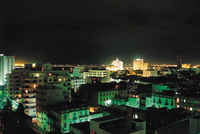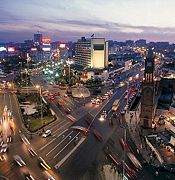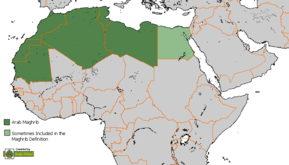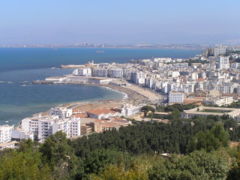Maghreb
2008/9 Schools Wikipedia Selection. Related subjects: African Geography; Geography of the Middle East
The Maghreb (المغرب العربي al-Maġrib al-ʿArabī), also rendered Maghrib (or rarely Moghreb), meaning "place of sunset" or " western" in Arabic, is a region in North Africa. The term is generally applied to all of Morocco, Algeria, and Tunisia, but in older Arabic usage pertained only to the area of the three countries between the high ranges of the Atlas Mountains and the Mediterranean Sea. Historically, some writers also included Spain, Portugal, Sicily and Malta in the definition, especially during the periods of Arab and Muslim domination. Malta, in particular, still speaks a language based on its own Maghrebi Arabic variety: Maltese. Partially isolated from the rest of the continent by the Atlas Mountains and the Sahara, the Maghreb has long been closely tied in terms of climate, landforms, population, economy, and history to the Mediterranean basin. Because sea transportation dominated people's lives for so long, peoples joined by waters shared more than those joined by land.
The region was united as a single political entity only during the first years of Arab rule (early 8th century), and again for several decades under the Almohads (1159–1229). The Arab states of North Africa established the Arab Maghreb Union in 1989 to promote cooperation and economic integration. Its members are Morocco, Algeria, Tunisia, Libya and Mauritania. Envisioned initially by Muammar al-Gaddafi as an Arab superstate, organization members expect eventually to function as a North African Common Market. Economic and political unrest, especially in Algeria, have hindered progress on the union’s joint goals.
Population


A majority of the current population in the Maghreb consider themselves generally Arab in identity, regardless of mixed ethnic or linguistic heritage. There are significant non-Arab or non-Arab identifying populations in the region.
Most important of the non-Arab populations found throughout the Maghreb, particularly in Morocco and Algeria, are the Berbers. They represented the majority of the pre-Islamic population. After the arrival of Islamic Arabs, Berbers assimilated in large numbers to Arab or mixed Arab-Berber ethnic identities.
Various other influences are also prominent throughout the Maghreb. In particular in northern coastal towns, several waves of European immigrants have influenced the population. Most notable were the moriscos and muladies, that is, indigenous Spaniards who had earlier converted to the Muslim faith and were fleeing, together with ethnic Arab and Berber Muslims, from the Catholic Reconquista. Other European contributions included French, Italians, and others captured by the corsairs.
Historically the Maghreb was home to significant Jewish communities, including the Berber Jews, who predated the 7th century introduction and conversion of the majority of Berbers to Islam. Later Spanish Sephardic Jews fleeing the Spanish Catholic Reconquista, established a presence in North Africa, chiefly in the urban trading centers. They have contributed to the wider population through conversion and assimilation. Many Sephardic Jews emigrated to North America in the early 20th century or to France and Israel later in the 20th century.
Among West Asians are Turks who came over with the expansion of the Ottoman Empire. A large Turkish descended population exists, particularly in Tunisia and Algeria.
Sub-Saharan Africans joined the population mix during centuries of trans-Saharan trade. Traders and slaves went to the Maghreb from the Sahel region. On the Saharan southern edge of the Maghreb are small communities of black populations, sometimes called Haratine, who are apparently descended from black populations who inhabited the Sahara during its last wet period and then migrated north.
In Algeria especially, a large European minority, the " pied noirs", immigrated and settled under French colonial rule. The overwhelming majority of these, however, left Algeria during and following the war for independence. France maintains a close relationship with the Maghreb countries.
The Maghreb shares a common culinary tradition. Habib Bourguiba defined it as the part of the Arab world where couscous is the staple food, as opposed to Eastern Arab countries where white rice is the staple food. In terms of food, similarities beyond the starches are found throughout the Arab world.
Religion
Historic records of religion in the Maghreb region show its gradual inclusion in the Classical World, with coastal colonies established first by Phoenicians, some Greeks, and later extensive conquest and colonization by the Romans. By the second century common era, the area had become a centre of Latin-speaking Christianity. Both Roman settlers and Romanized populations converted to Christianity. The region produced figures such as Christian Church writer Tertullian (c. 155 – c. 202); and Christian Church martyrs or leading figures such as St Cyprian of Carthage (+ 258); St. Monica; her son the philosopher St. Augustine, Bishop of Hippo I (+ 430) (1); and St Julia of Carthage (5th century).
The domination of Christianity ended when Arab invasions brought Islam in 647. Carthage fell in 698 and the remainder of the region followed in subsequent decades. Gradual Islamization proceeded, although surviving letters showed correspondence from regional Christians to Rome up until the ninth century. Christianity was still a living faith. Christian bishoprics and dioceses continued to be active, with relations continuing with Rome. As late as Pope Benedict VII (974-983) reign, a new Archbishop of Carthage was consecrated. Evidence of Christianity in the region then faded through the tenth century.
Islam
During the 7th century, the region's peoples began their nearly total conversion to Islam. There is a small but thriving Jewish community, as well as a small Christian community. Most Muslims follow the Sunni Maliki school. Small Ibadi communities remain in some areas. A strong tradition of venerating marabouts and saints' tombs is found throughout regions inhabited by Berbers. Any map of the region demonstrates the tradition by the proliferation of " Sidi"s, showing places named after the marabouts. Like some other religious traditions, this has substantially decreased over the twentieth century. A network of zaouias traditionally helped proliferate basic literacy and knowledge of Islam in rural regions.
History
After the end of the Ice Age about ten thousand years ago, when the Sahara dried up, contact between the Maghreb and sub-Saharan Africa was extremely limited. Arab expansion and the spread of Islam pushed the development of trans-Saharan trade. While restricted due to the cost and dangers, the trade was important and highly profitable. Peoples traded in such goods as salt, gold, ivory, and slaves available from the Sahel regions.
Paleo-anthropological evidence suggests that originally most of the Maghreb was inhabited by " Caucasoid" Cro-Magnoids ( Iberomaurusians) in the north. Later, about 8000 BC, "Caucasoid" speakers of northern Afro-Asiatic languages, such as Berber, came from the east, at least since the Capsian culture.
Many ports along the Maghreb coast were occupied by Phoenicians, particularly Carthaginians. With the defeat of Carthage, Rome took over many of these ports, and ultimately it took control of the entire Maghreb north of the Atlas Mountains. Remaining outside its control were only some of the most mountainous regions like the Moroccan Rif.
The Arabs reached the Maghreb in early Umayyad times. Their control over it was quite weak. Various Islamic "heresies", such as the Ibadis and the Shia, adopted by some Berbers, quickly threw off Caliphal control in the name of their interpretations of Islam.
The Arabic language became widespread only later, as a result of the invasion of the Banu Hilal (unleashed, ironically, by the Berber Fatimids in punishment for their Zirid clients' defection) in the 1100s. Throughout this period, the Maghreb most often was divided into three states roughly corresponding to modern Morocco, western Algeria, and eastern Algeria and Tunisia. The region was occasionally briefly unified, as under the Almohads, and briefly under the Hafsids).
After the Middle Ages, the Ottoman Empire loosely controlled the area east of Morocco. After the 19th century, areas of the Maghreb were colonized by France, Spain and later Italy.
Today more than two and a half million Maghrebin immigrants live in France, especially from Algeria. In addition, there are many more French of Maghrebin origin.
Maghrebi traders in Jewish history
In the tenth century, as the social and political environment in Baghdad became increasingly hostile to Jews, many Jewish traders emigrated to the Maghreb, especially Tunisia. Over the following two or three centuries, such Jewish traders became known as the Maghribis, a distinctive social group who traveled throughout the Mediterranean World. They passed this identification on from father to son.
Ecoregions of the Maghreb
The Maghreb is divided into a Mediterranean climate region in the north, and the arid Sahara to the south. The Magreb's variations in elevation, rainfall, temperature, and soils give rise to distinct communities of plants and animals. The World Wide Fund for Nature (WWF) identifies several distinct ecoregions in the Maghreb.
Mediterranean Maghreb
The portions of the Maghreb between the Atlas Mountains and the Mediterranean Sea, along with coastal Tripolitania and Cyrenaica in Libya, are home to Mediterranean forests, woodlands, and shrub. These ecoregions share many species of plants and animals with other portions of Mediterranean Basin. The southern extent of the Mediterranean Maghreb corresponds with the 100 mm isohyet, or the southern range of the European Olive (Olea europea) and Esparto Grass (Stipa tenacissima).
- Mediterranean acacia-argania dry woodlands and succulent thickets (Morocco, Canary Islands (Spain), Western Sahara)
- Mediterranean dry woodlands and steppe (Algeria, Egypt, Libya, Morocco, Tunisia)
- Mediterranean woodlands and forests (Algeria, Libya, Morocco, Tunisia)
- Mediterranean conifer and mixed forests (Algeria, Morocco, Tunisia, Spain)
- Mediterranean High Atlas juniper steppe (Morocco)
Saharan Maghreb
The Sahara extends across northern Africa from the Atlantic Ocean to the Red Sea. Its centre is hyper-arid and supports little plant or animal life, but the northern portion of the desert receives occasional winter rains, while the strip along the Atlantic coast receives moisture from marine fog, which nourish a greater variety of plants and animals. The northern edge of the Sahara corresponds to the 100 mm isohyet, which is also the northern range of the Date Palm (Phoenix dactylifera).
- North Saharan steppe and woodlands: This ecoregion lies along the northern edge of the Sahara, next to the Mediterranean forests, woodlands, and shrub ecoregions of the Mediterranean Maghreb and Cyrenaica. Winter rains sustain shrublands and dry woodlands that form a transition between the Mediterranean climate regions to the north and the hyper-arid Sahara proper to the south. It covers 1,675,300 square kilometers (646,800 square miles) in Algeria, Egypt, Libya, Mauritania, Morocco, Tunisia, and Western Sahara.
- Atlantic coastal desert: The Atlantic coastal desert occupies a narrow strip along the Atlantic coast, where fog generated offshore by the cool Canary Current provides sufficient moisture to sustain a variety of lichens, succulents, and shrubs. It covers 39,900 square kilometers (15,400 square miles) in Western Sahara and Mauritania.
- Sahara desert: This ecoregion covers the hyper-arid central portion of the Sahara where rainfall is minimal and sporadic. Vegetation is rare, and this ecoregion consists mostly of sand dunes ( erg), stone plateaus ( hamada), gravel plains (reg), dry valleys ( wadi), and salt flats. It covers 4,639,900 square kilometers (1,791,500 square miles) of Algeria, Chad, Egypt, Libya, Mali, Mauritania, Niger, and Sudan.
- Saharan halopytics: Seasonally-flooded saline depressions in the Maghreb are home to halophytic, or salt-adapted, plant communities. The Saharan halophytics cover 54,000 square kilometers (20,800 square miles), including Tunisian salt lakes of central Tunisia, Chott Melghir in Algeria, and other areas of Egypt, Algeria, Mauritania, and Western Sahara.
Modern territories of the Maghreb
- Algeria
- Ceuta (a Spanish exclave)
- Libya
- Mauritania
- Melilla (a Spanish exclave)
- Morocco
- Tunisia
- Western Sahara (claimed by Morocco)
Medieval regions of the Maghreb
- Ifriqiya
- Djerid
- Sous
- Zab
- Hodna
- Rif
- Maghreb al-Awsat (Central Maghreb)
- Morocco (Maghreb al-Aqsa)
- Tamesna
- Tripolitania

